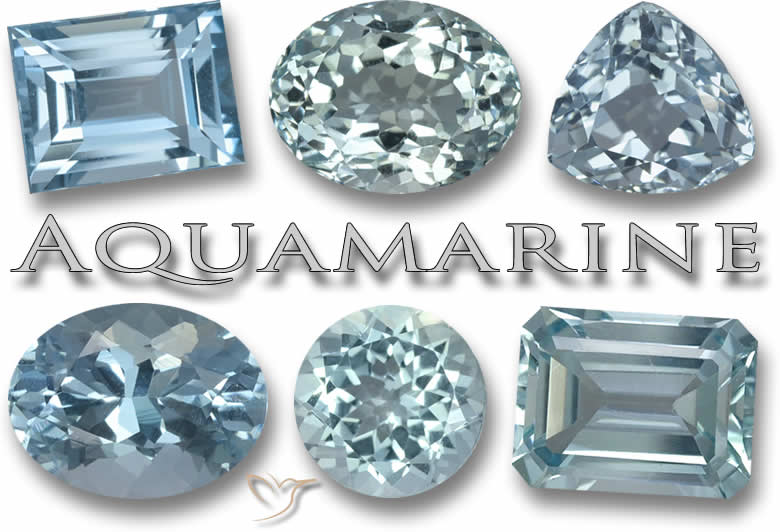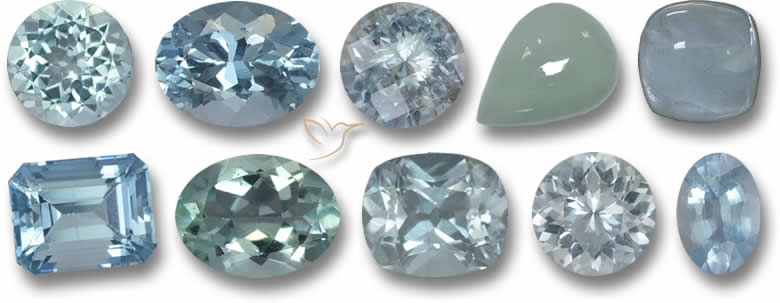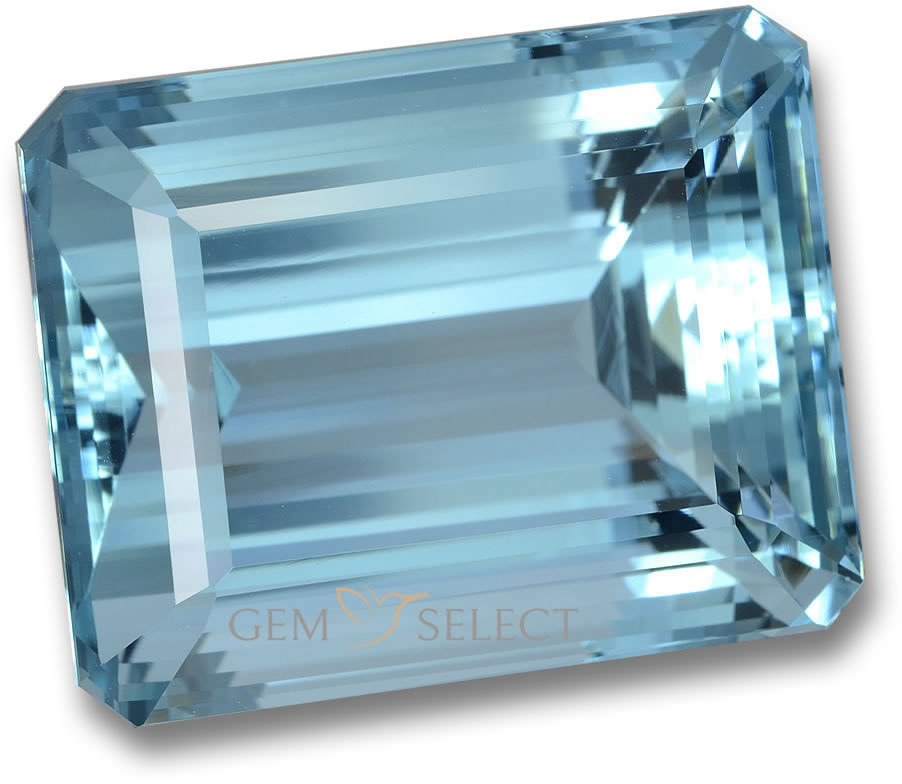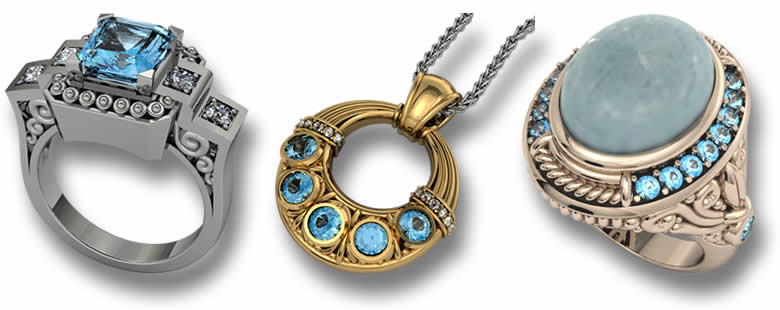Aquamarine Gemstone Information

Introduction
Aquamarines are surely one of nature's wonders. Stare into one of these beautifully cut, clear gemstones and you are instantly transported to the shores of an idyllic island. Instead of a crystal, you are looking into the transparent waters of the ocean of your dreams.
The word aquamarine comes from the Latin, aqua, meaning water and marina, which means 'from the sea' and when you look at one of these beautiful gemstones you will understand why.
When one imagines the calm sea waters lapping the white sandy shores of Mediterranean, Caribbean, or South Pacific islands, the color in our minds is usually aquamarine - and this is the color of the finest aquamarine gemstones too. From pale and light blues through to deep dark blues and some greenish blues as well, it is easy to figure out how both the color and the gemstone got their names.
Beryl is a mineral made up of beryllium aluminum cyclosilicate, most commonly found as crystals formed within igneous rock. The different types of beryl are created by the presence of trace elements such as chromium, iron, or manganese. Aquamarine is formed by minute quantities of iron being trapped within the beryl crystals as they grow.
Emerald is the most well-known of the beryl clan, but aquamarine is a very much sought-after semi-precious gem which has been used in both jewelry and for spiritual treatments for centuries. Learn more about aquamarine gemstones.
Aquamarine Colors

As the root of its name would suggest, the finest colors of aquamarine are reminiscent of the sea, and the more like a perfect translucent blue lagoon, the more attractive the stone is considered.
The intensity of the color is important, with dark blues and greenish blues being most valued. But admirers of aquamarine also appreciate the pale or pastel colors of a subtly tinted, crystal-clear gemstone.
A very important part of the value of color in aquamarine, as it is with most gemstones, is the evenness of the color - a consistent tone throughout the crystal with no visible color zoning.
The Santa Maria Aquamarine is a uniquely saturated blue gemstone originally mined in Santa Maria de Itabira in Brazil. They are the most valuable and sought-after, but unfortunately, the original mine has been virtually exhausted. The term Santa Maria can now sometimes refer to an aquamarine crystal from anywhere but possessing this particular coloring. However, more scrupulous gem dealers should identify the source. For example, some beautiful gemstones of a similar color and saturation from Mozambique and Zambia have been dubbed Santa Maria Afrique to distinguish them from the Brazilian mine.

Another vibrant blue aquamarine is the Double Blue, recently discovered and mined in Madagascar.
The color of aquamarine gemstones can change dramatically when viewed from different angles, but this is only really apparent in deeply colored stones where the color change can be from strong blue to almost colorless. The technical term for this is pleochroism. Isn't that fascinating how light plays with these stones?
Aquamarine Species
Aquamarine is part of the beryl family of gemstones and is similar in chemical makeup to other members, such as emerald, morganite, yellow beryl, and so on. What really sets it apart as aquamarine is its light blue to dark blue colors with hints of green.
Aquamarine is a highly regarded semi-precious stone able to command some good prices, so it is not surprising that some unscrupulous merchants have tried to take advantage of this good name. Brazilian Aquamarine may or may not come from Brazil and is often used as a false name for blue topaz; Siam Aquamarine is usually a blue zircon, while Nerchinsk is also more likely to be topaz.
Aquamarine Clarity
Part of the aquamarine charm is its resemblance to cool blue seas, so gemstones of high clarity are especially important in order to conjure up those images of white sands, colorful fish, and spectacular coral visible clearly through shimmering blue water.
Nearly all aquamarines deemed good enough for the gems market are eye-clean, that is, no blemishes or inclusions are visible to the naked eye.
This is especially important as aquamarine tends to be transparent and light in color.
Stones which do have eye-visible inclusions are often cut into cabochons or beads or sometimes fancy carvings. Explore cat's eye aquamarine details.
What is the Spiritual Meaning of Aquamarine?
Disclaimer: The following information on spiritual meanings is based on historical and cultural beliefs and is not supported by scientific evidence. It is provided for informational purposes only and should not replace professional advice.
As soon as you look upon a large aquamarine crystal, a feeling of serenity and relaxation will envelope you. The cool blue color is so evocative of a calm and inviting tropical sea that you are tempted to dive in!
The water element is a large part of the crystal's legend. Sailors believed that aquamarine was a gift from mermaids and would wear it to protect them from drowning or simply prevent sea sickness. They would also decorate their vessels with gemstones to encourage calm seas and thus save them from sinking.
Aquamarine is connected to the moon, and we all know the moon's influence over us and the seas. It is also the traditional Pisces gemstone, so if Pisces is present in your astrological chart, then you might want to bring one of these crystals into your life.
A stone for calming the sea waters was also seen as a perfect amulet for calming the storms in a marriage, so a gift of an aquamarine from husband to wife smoothed the rough waters of the home, too.
Back in ancient Rome, lovers would exchange gifts of aquamarine to signify pure love rather than lust in their relationship. An aquamarine is an especially good idea for the 19th wedding anniversary, for which it is the official gemstone.
In keeping with the feeling of calm waters and clear blue skies, aquamarine can relieve the stresses of day-to-day life and helps you to relax. Aquamarine's bestowing of a feeling of serenity makes it a perfect crystal for meditation.
Finally, the aquamarine gemstones we see and admire look so pure and clear that it is symbolic of their power to keep all impurities away in your life - so protective that evil cannot exist in its proximity. Discover aquamarine meaning, powers, and uses.
Aquamarine Health Benefits
Disclaimer: The following information on health benefits is based on historical and cultural beliefs and is not supported by scientific evidence. It is provided for informational purposes only and should not replace professional medical advice.
Aquamarine is described as a panacea for many ailments. Pregnant women can wear this gemstone to protect both mother and baby from harm. It boosts your immune system, heals sore throats, helps prevent thyroid problems, and relieves allergic reactions. It is especially beneficial in all matters to do with the throat, liver, and stomach.
Mental health is just as important, and aquamarine can heal there too - it reduces stress and anxiety and washes your worries away. It improves logic, encourages discipline of the mind, and allows you to calmly and intelligently tackle life's awkward questions.
At work, it can motivate, bring out inner strengths, nurture relationships with colleagues, and give you the confidence to progress your career.
Water is essential for all forms of life, and throughout history, it has been revered by man for its cleansing, nourishing, and blessing qualities. Almost every culture past and present uses water in religious or spiritual rites. Aquamarine is the embodiment of water and can be regarded as an all-encompassing health benefit.
Aquamarine Price
Aquamarine Price List |
||
|
Color |
Weight range |
Price range / USD |
|---|---|---|
|
Blue |
1 - 5ct |
$20 - $500/ct |
|
Blue |
5ct + |
$70 - $1000/ct |
The price of aquamarine is largely determined by its color. The most valuable color is dark blue or perhaps a slightly greenish blue, but the richer and darker the blue, the better. A prime example of this deep saturated blue is the Santa Maria aquamarine. These were originally from Brazil, but now similar colored stones are sourced in mines in Africa and Pakistan as the Brazilian mines were depleted. The Santa Maria aquamarines are the most highly sought and most expensive but should not be confused with less valuable Espirito Santo Aquamarine or Santa Maria Topaz.
Aquamarines are usually highly clear, transparent stones, so avoid gems with a lot of inclusions, blemishes, or cracks.
This high transparency influences the cut of aquamarine. It is a highly reflective gemstone, and the cut should make the most of this asset. Emerald or step cuts are very popular, and angles are best sharp and straight, enhancing the sparkle and keeping the light directed to the eye. A poorly cut crystal will lower the value.

Aquamarine can be found in fairly large sizes, but it is color and clarity that make the price. Cutters will sacrifice the blemished or impure parts of the stone to create a smaller, strongly colored stone. A small transparent stone of saturated deep blue will be worth a stone twice its size if it is pale with inclusions.
Although Brazil was once the prime source of the valuable Santa Maria aquamarine, those mines have been exhausted, and now it is only color that really determines the value, not where the gemstones come from. So long as they possess that strong blue color, they can be mined in Madagascar, Burma, or Colorado!
Original documented gems with good color from Siberia or Brazil are highly valued.
Aquamarine Discovery
Aquamarine has been used as jewelry and as an amulet for at least 3000 years, with references in Sumerian, Egyptian, Greek, and Roman writings. Greeks called it the sailor's friend or the sailor's stone, and famed Roman philosopher Pliny suggested
'the lovely aquamarine . . . . seems to have come from some mermaid's treasure house'.
In those days, it was not called aquamarine but 'sea-green beryl,' and in some ancient texts, it was one of the seven sacred stones taken to sea to ensure a safe return.
The earliest known use of the term 'aquamarine' in connection with the gemstone was in 1609 when Anselmus de Boodt published his gemological work, Germmarum et Lapidum Historia. The word comes from the Latin aqua meaning water and marina meaning sea.
The first documented modern-day discovery of Aquamarine took place in 1723 in the mountains of Siberia.
Deposits found at this site were plentiful, and it soon became the world's principal mining site, with more than seventy kilograms of high-quality gemstones mined in 1796.
A few decades later, on the other side of the world in Brazil, amongst the gold, topaz, diamonds, and emeralds, an enormous supply of aquamarine was discovered in the Marambaia Valley. This area has supplied the majority of the gemstones ever since, including some truly enormous specimens such as the 110-kilogram near-perfect stone discovered in 1910. From this one gem, cutters faceted 100,000 carats of high-quality aquamarines. Those who saw the original whole crystal claimed it was so transparent that distant objects could be seen through its length!
Where is Aquamarine Found?

The Aquamarine mines of Brazil have been going strong for nearly three centuries (in fact, the 300-year anniversary of Minas-Gerais was celebrated in 2019), and still produce the majority of gemstones to this day.
Beautiful, 'water clear' stones are sourced high in the mountains of Pakistan in southern Asia. It supplies the world with some of the finest stones, but miners have to ascend to 3000 or even 4000 meters to get them!
Other important sources of Aquamarine include Kenya, Zambia, Nigeria, Madagascar, and Mozambique in Africa; China and Myanmar in Asia; Russia and Ukraine in Europe; and Colorado in the US.
How is Aquamarine Formed?
When molten lava or magma cools and solidifies, it becomes igneous rock. Lava is on the surface of the earth and cools very quickly. Magma is underground and cools slowly. Crystals need a very long time to form, and so they grow in the slow-cooling magma rocks known as pegmatite. Pegmatite rock is filled with cracks and fissures. It is in these cracks that thermal activity forms crystals such as the beryl family. Beryl is an aluminum silicate mineral, and when mixed with finite amounts of other minerals, magic happens. Beryl crystals with a touch of chromium give us Emerald, some manganese and we get Morganite, or add a little iron and you produce Aquamarine.
Pegmatites are found in mountain ranges on every continent and usually most abundant in rocks of great geological age. With all this material spread about the world, you would think gemstones are easy to find, but it is estimated that only 0.003% of all magma rocks contain beryl-rich pegmatites.
Aquamarine Treatments
In a sense, all gemstones are treated in one way or another - when rough rocks are mined from the earth, they need to be cut and polished for their beauty to be appreciated. However, there are further treatments which may or may not enhance their appearance, such as bleaching, coating, dyeing, filling, irradiation, and heating. Opinions may differ on the efficacy and ethics of such treatments, but no doubt all information must be passed onto any potential buyers.
We at GemSelect have a wide range of mostly untreated stunning aquamarine gemstones, and any treatments are fully disclosed. Browse our aquamarine gemstone collection.
The deep blue aquamarines are the most valued, and heat treatment can be applied to enhance the color. Gentle heat is applied, and it is permanent and widely accepted in the gemstone industry. Heat-treated blue aquamarines are certainly attractive, but they are not as valuable as naturally occurring untreated blue gemstones. Make sure you are aware of any treatments your stone has had.
What Jewelry is Aquamarine Suitable For?

Aquamarine has a reading of 7.5 to 8 on the Mohs scale for gem-quality stones, just below that of sapphires and rubies, so it is perfect for rings, earrings, necklaces, bracelets, and pendants that can be worn every day. Aquamarine can be cut into any style; ovals, pears, rounds, and emerald cuts are particularly popular.
While aquamarine gemstones are strong enough to withstand the rigors of daily wear, care should be taken to avoid any sharp blows and should be stored carefully to avoid contact with harder materials which could break, chip, or scratch the gem. Being such a hard stone, aquamarine will not scratch easily, but be aware it can scratch other gemstones, so be careful when storing to keep your gemstones in separate containers.
These days, people are looking for interesting alternatives to diamonds for engagement rings, and the aquamarine is certainly durable and beautiful enough to be this most important token of love.
The cool blue colors are ideal for any eye color and will match most outfits too.
Did You Know? Interesting Facts about Aquamarine
- Aquamarine is the birthstone for March
- Aquamarine makes a perfect gift for a loved one born in this month. It is also the gemstone to celebrate the 19th wedding anniversary, and there really could not be a better token of love than this rare and beautiful crystal.
- The largest cut aquamarine is the Dom Pedro
- Originally three feet long (nearly a meter) and weighing a hundred pounds (about 45 kilos), it was actually dropped by the prospectors - doh! Two broken pieces were sold off, but the largest remaining piece was named Dom Pedro after Brazil's first emperor. The uncut Dom Pedro aquamarine crystal was put into the hands of master craftsman Bernd Munsteiner. He worked on the gemstone for ten months, turning it into the 10,000-carat work of art which now resides in the Smithsonian in Washington DC. Read about the Dom Pedro aquamarine.
- The Romans believed a frog etched into a piece of aquamarine could bring peace to warring parties.
- For her coronation in 1953, Queen Elizabeth II received a gift from the president and people of Brazil
- It was made by Mappin and Webb and consisted of a necklace and matching earrings. The necklace contained nine large oblong aquamarine stones, and the earrings had matching drop aquamarine pendants.
- Aquamarine's link with the world of sailors and the sea has continued to the modern world. The US navy created a coastal patrol yacht in the second world war and named it the USS Aquamarine.
- In the middle ages, aquamarines were fashioned into spectacles to correct short sightedness. Even today, the German word for eyeglasses is 'brille,' which comes from the mineral beryl.
- The Brazilian government also sent a gift to the wife of US president Franklin D Roosevelt
- A step-cut rectangular aquamarine was cut into a 1300-carat faceted stone and presented to First Lady Eleanor Roosevelt. It is now in the Presidential Library.
- Aquamarine is the official stone of the 38th state of America, Colorado. Some fine-quality aquamarine gemstones have been found in Mount Antero and White Mountain in this rugged state.
- Fashion tastes change over time
- In Victorian times, the most popular and expensive aquamarines had a green tinge, and the bluer colors were seen as too garish! Nowadays, the greener colors are far less desirable.
How to Care for Aquamarine
Aquamarine's hardness (7.5 to 8 on the Mohs scale) makes it durable and means that it does not scratch easily. It is strong enough for nearly all types of jewelry. One thing to be especially careful with aquamarine is its sensitivity to chemicals such as ammonia, alcohol, and many acids.
Keep aquamarine away from any source of strong or high heat, as this can be very detrimental to coloring. Also, try not to keep your aquamarine in direct sunlight, as some stones can fade if exposed for too long.
To clean your aquamarine, simply use soapy water and a soft cloth. Be sure to rinse well to remove soapy residue. As with most gemstones, ultrasonic cleaners and steamers are not recommended.
Always remove any jewelry or gemstones before exercising, cleaning, or engaging in harsh physical activities such as sports.
Store aquamarine away from other gemstones to avoid scratches. It is best to wrap gemstones in soft cloth or place them inside a fabric-lined jewelry box.
How Can You Tell a Real Aquamarine?

Obviously, a certified gemstone from a reputable dealer is the best approach, but this is not always possible when you are out searching for a great gemstone or a bargain!
First, check the color; aquamarine ranges from light sky blue to deep ocean blue - any other color should be taken as a warning that things are not right. However, there are other well-known blue stones out there that are not aquamarines.
Aquamarine is a very hard stone; surface scratches could mean the gemstone is made of glass or a lesser-quality stone. At nearly 8 on the hardness scale, aquamarine will not be able to be scratched by your fingernail or even a penknife.
Aquamarine gemstones are usually eye-clean; there should not be any visible blemishes, bubbles, or material within the stone.
Coolness test: Touch the gemstone to your forehead; if it feels room temperature, it is likely to be glass - aquamarine will feel pleasantly cool.
Price as a guide: Aquamarine is a rare semi-precious gemstone, so the price should reflect this. If you see a prime example at a price too good to be true, it probably isn't true, so avoid buying such 'bargains.'
Look at the gem from different angles; it should change color from blue to near colorless due to the pleochroic nature of the gemstone. If it does not change color, be wary.
This is not a complete guide on how to spot a fake aquamarine gemstone, but I hope it helps.
At GemSelect, we currently offer brief identification reports from your choice of two well-respected independent gemological laboratories, The Asian Institute of Gemological Sciences (AIGS) and Burapha Gemological Laboratory (BGL Lab).
What is So Special about Aquamarine?
Aquamarines have a special blue color that is so like the ocean, you are tempted to dive in! Their clarity and transparency is almost unsurpassed, especially in the bigger sizes that are available in this unique gemstone.
They are a cutter's dream gemstone, carving cleanly with little or no risk of cleaving or breaking. Any shape is possible, and with such lovely clear large sizes available, aquamarine is often used by cutters to experiment with new contours and designs.
The subtle cool blue color suggests class and sophistication - a gorgeous alternative to some of the more flashy gemstones out there.
Can Aquamarine Change Color?
Some gemstones show a distinct or dramatic change in color under different light sources. Look at a color-change garnet under electric or artificial light, and it could look red; take it outside into the sunlight, and all of a sudden it is green! This remarkable effect only occurs in a few gemstones, Alexandrite, color-change Garnet, color-change Sapphires being the most well-known.
Aquamarine does not really change color under different light, although some examples do seem to become slightly brighter under artificial light.
Because of aquamarine's crystal structure, it can appear to change color when viewed from different angles, in this case from blue to near colorless - a phenomenon called pleochroism.
How Can You Tell a Good Quality Aquamarine?
As with all colored gemstones, the quality of an aquamarine comes down to the 4 Cs: color, clarity, cut, and carat. With aquamarine, the color is vital. Personal preference takes precedence, of course, but it is the deep saturated blues that command the highest prices.
The light and subtle hues that aquamarines are famous for means that clarity is paramount when judging an aquamarine gemstone; there must be no visible blemishes.
A beautifully colored, crystal-clear gemstone can be ruined by a less-than-perfect cut, so take care in selecting a well-faceted aquamarine that shows off its brilliance, transparency, and color-change capabilities. A rectangular or square emerald cut is very popular with aquamarine gemstones, but any shape is possible with this durable gem, and some fancy faceting is possible, especially with the large sizes available.
Carat is the final consideration and is probably the least important with aquamarine. They are reasonably common in large sizes, so do not compromise color, clarity, and cut for the sake of a large stone.
Aquamarine - Gemological Properties
|
Chemical Formula: |
Al2Be3Si6O18, Aluminum beryllium silicate |
|
Crystal Structure: |
Hexagonal, hexagonal prisms |
|
Color: |
Light-blue to dark-blue, blue-green |
|
Hardness: |
7.5 - 8 on the Mohs scale |
|
Refractive Index: |
1.564 - 1.596 |
|
Density: |
2.68 - 2.74 |
|
Cleavage: |
Indistinct |
|
Transparency: |
Transparent to opaque |
|
Double Refraction or Birefringence: |
-0.004 to -0.005 |
|
Luster: |
Vitreous |
|
Fluorescence: |
None |
Frequently Asked Questions
What colors does aquamarine come in?
Aquamarine ranges from pale light blues to deep dark blues, with some greenish blues. The most valued are the saturated dark blues reminiscent of ocean waters.
Is aquamarine a type of beryl?
Yes, aquamarine is a variety of beryl, distinguished by its blue color caused by trace amounts of iron.
How clear should an aquamarine be?
High-quality aquamarines are eye-clean, meaning no visible inclusions or blemishes to the naked eye, enhancing their transparent, sea-like appearance.
What is the price range for aquamarine?
Prices vary by color, size, and quality, typically ranging from $20 to $1000 per carat, with deeper blues commanding higher values.
Where is aquamarine mined?
Major sources include Brazil, Pakistan, Madagascar, and various African countries like Kenya and Zambia.
Are aquamarines treated?
Many are heat-treated to enhance blue color, a permanent and accepted practice, but untreated stones are more valuable.
Is aquamarine suitable for everyday jewelry?
Yes, with a hardness of 7.5-8 on the Mohs scale, it's durable for rings, earrings, and more, though care should be taken to avoid harsh chemicals.
How do I clean aquamarine?
Use soapy water and a soft cloth, rinse well, and avoid ultrasonic cleaners or steamers.
Can aquamarine change color?
It exhibits pleochroism, appearing to change from blue to colorless from different angles, but not dramatically under different lights.
What makes a high-quality aquamarine?
Look for deep, even color, high clarity, excellent cut, and appropriate carat weight without compromising the other factors.

